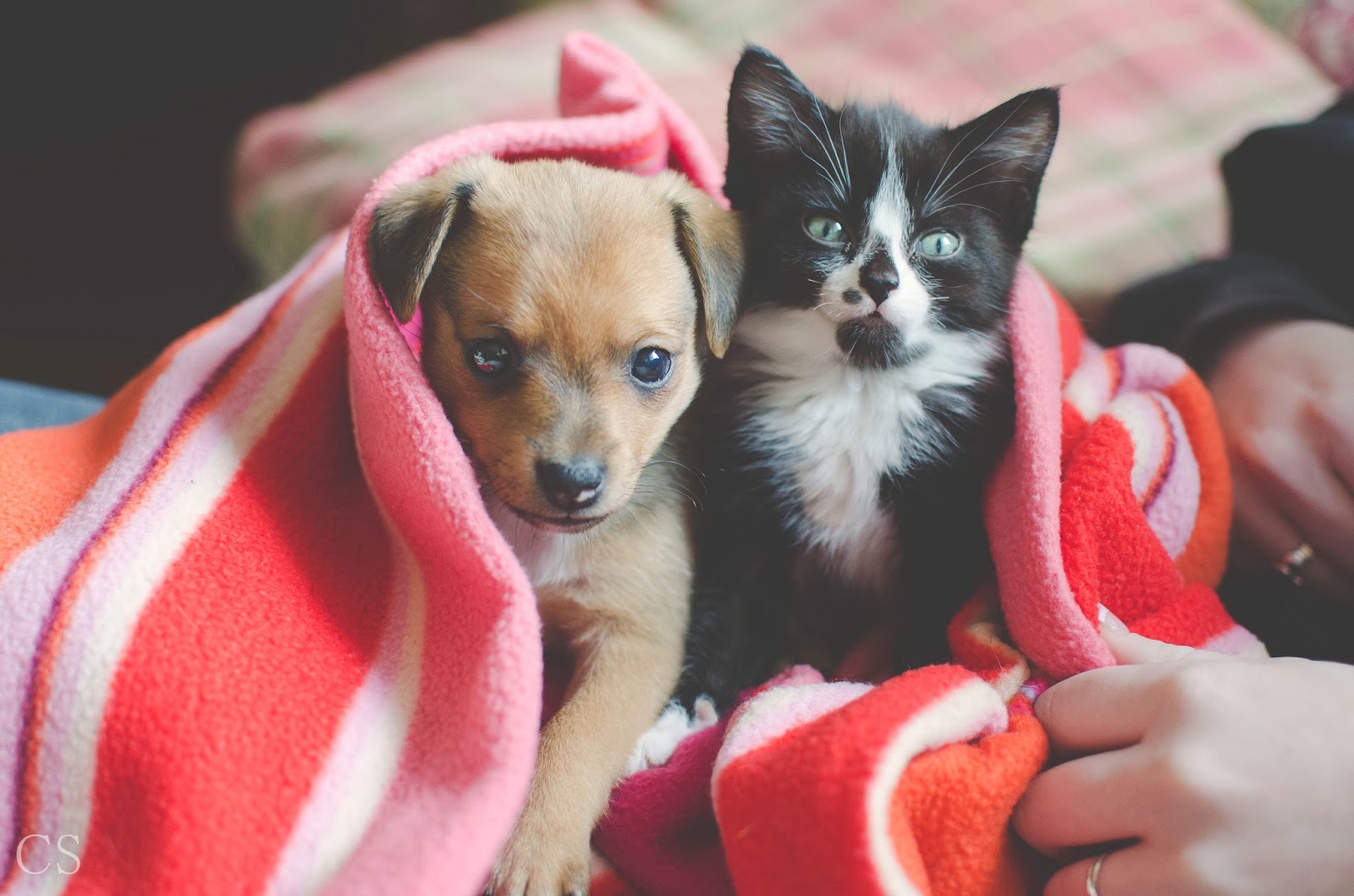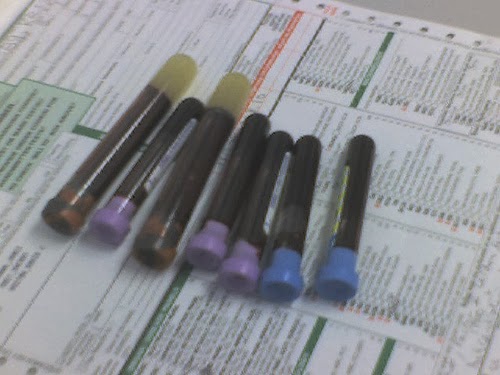Woof Talk Right Meow
Translate
Sunday, April 13, 2014
Solutions for dogs and cats scooting their butt on the ground continued.
The most common reason for your pet(s) to scoot their butt on the ground is anal glands, which we discussed last week. So what if your dog is scooting their butt on the ground, but it’s not the anal glands?
First, check to make sure your pet(s) does not have tapeworms (to read a review on tapeworms, visit previous posts). Tapeworms can be irritating to your pet’s rectum, so they might cause them to rub their butts on the ground. If tapeworms are present, bring a fresh stool sample into your local veterinarian’s office. A Veterinary Technician will first do a gross examination, which is physically looking at the stool sample with their eyes only. There may be segments of the tapeworm present in the stool that they can visually see without a microscope.
After the gross examination, the Veterinary Technician will then set up a “fecal float”. The fecal float will usually take 10 minutes to bring up any parasite eggs, although some may let it sit for longer. Once the 10 minutes have past, the Veterinary Technician will take the cover slip and place it on a slide. They will exam the slide underneath a microscope, to see if any parasite eggs are present. Once the microscopic examination is complete, the Veterinary Technician will report the findings to the Veterinarian.
If tapeworms are the only parasite found, the Veterinarian will usually give you the option of taking home one or two Droncit pills (one given now and usually a follow up one is given two weeks later, to make sure the tapeworm is gone) or a Droncit shot. If other parasites were found, your Veterinarian will most likely prescribe an alternative medication that is able to treat more than one of the parasites.
If you checked your pets butt and no tapeworms are present, check to see if there is any dry fecal matter or any other material present that may be irritating your pet’s rectum. If you find fecal matter or other material present, you can use a baby wipe or warm wet cloth to clean the area. You may have to cut off some of the fur if it’s really stuck on there. Please be very careful when using scissors on your pet(s), you do not want them to jump, which could lead to you cutting them.
If you checked your pets butt and found no tapeworms, fecal matter, or any other material is present, your pet may be constipated. My pet advice is to monitor your pet to make sure that when they go outside that they indeed have a nice bowel movement. If your pet(s) does not have a bowel movement in a couple days, you can try increasing their fiber intake by giving them 100% natural canned pumpkin or a stool softener.
Please call your local Veterinarian for proper dosages. Special note: If your pet is experiencing constipation accompanied by not eating, drinking, vomiting, lethargic, or abnormal behavior (any of these), your pet may have an obstruction. If you suspect an obstruction, please bring your pet to your local veterinarian immediately, as these can be life threatening if left untreated.
So if none of the above is causing your pet(s) to scoot their butt on the ground, another reason that may be causing their rectum to be irritated is a skin infection. A skin infection can be a bacterial infections (Several types, and some can be passed to humans), yeast infections, and/ or a fungal infection (ringworm can be passed to humans). Usually, if your pet(s) has yeast infection, you will be able to smell it (bread baking), and feel it. The fur usually feels like there is a film on it.
If it’s a bacterial infection, you may also be able to smell it. In addition to smelling your pet(s), by just looking at your pet(s) skin surrounding the rectum, you may be able to see redness, loss of fur, scabs, discharge, ect. If you suspect your pet(s) has an infection of any kind, please bring them into your local veterinarian’s office ASAP. If you wait too long, the infection will get worse, and sometimes pets will pull their hair out, causing a moist dermatitis, which is commonly known as a “hot spot”. As always, it’s easier and cheaper to treat your pet(s) in the early stages.
So if your pet has none of the above, they may have allergies. They can be allergic to the food you are feeding them, and also things in the natural environment. It is important to monitor your pet(s) normal activities on a regular basis, so you are able to tell when your pet(s) are acting strange.
Please return soon, to learn more about keeping your pets happy and healthy.
Sunday, April 6, 2014
Solutions for dogs and cats scooting their butt on the ground
Some pets have difficulty expressing their anal glands naturally, due to being overweight, not enough fiber in their diet, and so on. With that said, if your pet is showing signs of full/blocked anal glands such as: scooting their butt on the ground, chasing their tail, biting the base of tail/lower back, and excessive licking; it is best to address the issue ASAP before the anal glands become a bigger issue.
If you are not familiar with expressing anal glands, I highly suggest you have a veterinary professional express them. Anal glands can easily be expressed at home; if you are interested in learning how, ask your veterinary technician to show you. A groomer can also express anal glands also, but they usually express them externally (from the outside), and if your pet(s) is showing signs of discomfort, they need to be expressed internally.
If you remember from last week’s post, your pet’s two anal glands are located at 4’o clock and 8’o clock. Your veterinary technician will put a pair of latex gloves on, and apply lubrication to one of their index fingers. They will insert their lubricated index finger into your pet’s rectum, and go to the 6’o clock position, feeling for the full anal gland. Once found, they will apply slight pressure with their index finger on the inside and their thumb on the outside pulling outwards/downwards towards the opening of the rectum. Once the anal gland is emptied, a strong fishy smell will be present. Most technicians will place a paper towel covering the outside of the rectum, to prevent getting any anal fluids on their shirts or even worse, their face. Once one gland is expressed/emptied, they will move to the next one and follow the same steps. After both glands are emptied, usually the technician will clean your pet’s rectum and surrounding area with a baby wipe. Some technicians will also spray a pet safe perfume, to help minimize the smell for the owner. Side note: Your pet will be restrained during the anal gland expressing process, and may require a muzzle. The muzzle is to protect your pet and the technicians.
Once your pet(s) is all cleaned up, the technician will save the fluid emptied from the anal glands if they feel there might be an infection, and show the fluid to the veterinarian. If your pet(s) has fluid that is an abnormal color, such as white, green, yellow, or red there is an infection that will most likely require a round of antibiotics. Your veterinarian may prescribe an anti-inflammatory too. If your pet(s) anal glands were so full that they ruptured/abscessed, the veterinarian will most likely want to flushed out the glands in addition to medication. In most cases, veterinarians recommend your pet(s) to come back in two-three weeks for the glands to be expressed again, and to make sure the infection is cleared up. Once your veterinarian feels the infection and inflammation is cleared up, they will most likely recommend your pet(s) having their anal glands expressed regularly.
How often your pet(s) need their anal glands expressed can be reduced by increasing their fiber. The fiber helps bulk up their stool, helping to express the glands when they have a bowel movement. An easy way to increase fiber in your pet’s diet is canned pumpkin. Not the pie filling pumpkin, but actual 100% natural/pure canned pumpkin. The recommend dose varies depending on the size of your pet(s), usually one tablespoon to two tablespoons. Please call your veterinarian to find out exactly how much to give your pet(s). If your pet(s) refuse to eat the pumpkin, you can also try Metamucil. Again please call your veterinarian for proper dosing.
If you do not want to give your pet(s) the added fiber supplements, your pet(s) may benefit from changing their current diet to a higher fiber food. In addition, make sure your pet(s) are getting enough water in their diet. If you feel your pet’s water intake is small, you may want to add wet food into their diet. Most canned foods are 70% water.
If your veterinarian determines the reason for your pet(s) scooting is not caused by full anal glands, and tells you it’s due to tapeworms or some kind of skin infection, it’s a pretty easy fix with proper prescription medication. The hardest thing to treat that can be causing your pet to be scooting their butt on the ground is fleas. If you need help getting rid of fleas, please visit my earlier posts.
Please return next week to learn more solutions for your dog or cat scooting their butt on the ground. Let’s keep learning about keeping your pet(s) happy and healthy.
Sunday, March 30, 2014
Reasons for my dog or cat scooting butt on ground
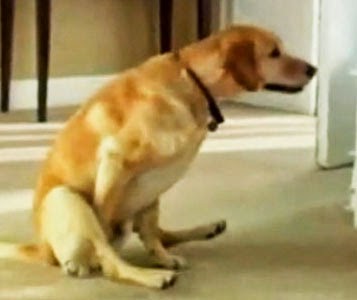 |
| Dog scooting butt on ground |
The first most common thing to check would be the “Anal Glands.” Dogs and cats have two anal glands located at 4 o’clock & 8 o’clock, which are normally excreted when they pass a bowl movement. The anal glands have a fishy bad smell to us humans, but to them it smells great. At times the glands are not being able to empty properly, so they fill up with fluid, which then causes your dog or cat to rub their anus on the ground because it is inflamed and irritated. Sometimes the glands can become so “blocked”, that they actually rupture. If that happens, immediate veterinary treatment is needed.
Another reason for your dog or cat to rub their butt on the floor is tapeworms. Dogs and cats get tapeworms from ingesting a flea that has tapeworms. If your dog or cat has tapeworms, it will look like “white rice” coming out of their anus, which are actually segments of the tapeworm.
Another reason for your dog or cat to rub their butt on the floor is constipation. Not passing a bowel movement can be irritating to your dog or cat. The opposite of constipation is diarrhea, which can also cause your dog or cat to scoot their butt on the floor. Having diarrhea can irritate the anus and cause burning, along with inflammation. In addition, they may have fecal matter stuck in their fur, which causes more irritation.
These are the most common reasons dogs and cats scoot their butt on the ground. Other things not mentioned above such as allergies, skin fold infections, fleas, and prolapsed rectum etc, can also contribute to your dog or cat scooting your butt on the ground.
Please return next week to learn solutions for your dog or cat scooting their butt on the ground. Let’s keep learning about keeping your pet(s) happy and healthy.
Sunday, March 23, 2014
The truth about declawing your cat
Cats usually have five toes on each paw, but sometimes, they may have an extra toe or two, which is called “polydactyl.” Before you decide to have your cat declawed, let me explain, what declawing actually does to your cat.
 |
| Polydactyl Cat |
Now sometimes elderly people think if they get their cat(s) declawed it will prevent the cat(s) from injuring them, but that’s not the case. When cats no longer have their claws, they are more likely to start biting, which can cause more harm than scratching.
My pet advice is to start playing with your kitten’s paws and toes right away, so they get used to having their paws touched. This will enable, the owner or veterinary professional to trim your cats nails, without having it be a stressful experience. In my personal experience, this is the best way to make trimming nails, an easy fast experience.
I trim all of my cat’s nails, including family member’s cats, by myself. I can do this, because I am a certified veterinary technician with a lot of experience trimming nails, but you as an owner can do it too. It takes a lot of practice, and you have to be consistent. It is hard to explain in just words how to properly trim your cats nails, so if you are interested, you should ask your veterinary technician to show you.
In addition, to nail trimming every two weeks, try getting cat tree houses and scratching posts. Put some cat nip on the tree house or cat post, and your cat should start scratching.
If you still feel like declawing is your only option, please find a veterinarian that performs the declawing with a surgical laser. I have seen all three methods, and the surgical laser is by far the best way. Cats recover much faster and seem to be in less pain, when the surgical laser is used.
As always, feel free to ask any question you may have in the comment section below.
Please return next week to learn more about keeping your pet(s) happy and healthy.
Saturday, March 15, 2014
Solutions for cat urinating outside the litter box
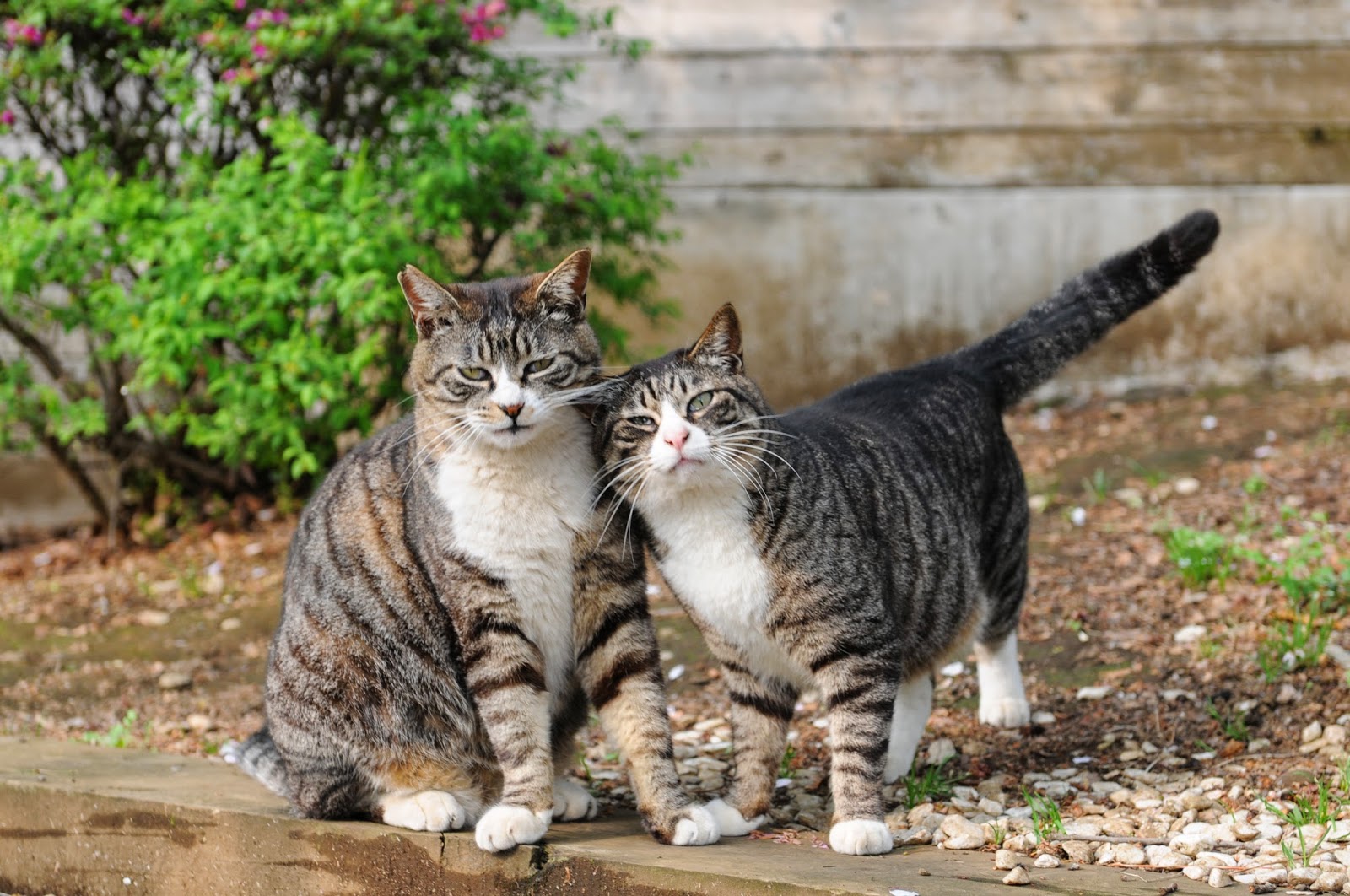 |
| Two happy kitters |
My last post, explained the reasons why cats urinate outside the litter box, along with some solutions. But if you have tried all those things, and your cat(s) is still urinating outside the litter box, there are a few things more things that might help
Feliway
Feliway can be purchased at your local pet store. Feliway is available in a spray or an air plug diffuser. The product works by producing the pheromones that help your cat(s) relax and distress. These pheromones are normally produced by your cat(s) when rubbing their face on you or furniture.
It’s important to note, you may not see any results until after a month. With that said, don’t give up until at least one month of using the product.
I have personal experience with Feliway and it truly works. My female cat had a problem with urinating on anything you left on the floor, but Feliway helped greatly reduce her urinating issue for two whole years. After two years, it was no longer effective, and I had to go a different route, which I will discuss next.
For more information on Feliway please visit http://www.feliway.us/Frequently-Asked-Questions
Fluoxetine, more commonly known as Prozac
Prozac is only available through your veterinarian, and will require medical testing before it can be prescribed for your cat(s). Usually a urinalysis and urine culture will be performed, along with blood tests, such as profile and cbc. If you need a review on what a profile and cbc checks for, please visit My pet advice on vaccinations
Once all tests have come back normal, your veterinarian will most likely prescribe Prozac, because it has the best results compared to other drugs used for urine marking in cats.
The drug works by helping your cat produce more serotonin, which makes your cat(s) feel better. It takes two weeks for the drug to start working, so do not give up. Once the drug is in your cat(s) system, your cat(s) should no longer urinate in undesired places, only the litter box.
As mentioned earlier, I have personal experience with Prozac, and it worked for my female cat, for one whole year. Once the year was over, I decided to take her off of it, which you have to do slowly. She did not have an accident for months after being off the Prozac, but after moving she started again. I did not want her back on the Prozac, so I started the Feliway again.
Currently, she will have an accident, only if I forget to clean the litter boxes or leave towels on the floor.
Dealing with cats that have urinating issues is a continuous battle, but if you are consistent with your treatment, your cat(s) should be manageable.
Remember your cat(s) is not urinating to make you mad, they are experiencing stress, anxiety or fear. Please be understanding and do not yell at your cat(s). Yelling will only increase your cat(s) anxiety and worsen the issue.
Try to stay calm and just imagine what your cat(s) is feeling inside.
As always, feel free to ask any questions you may have in the comment sections below.
Please return next week to learn more about keeping your pet(s) happy and healthy.
Sunday, March 2, 2014
Cat urinating outside litter box
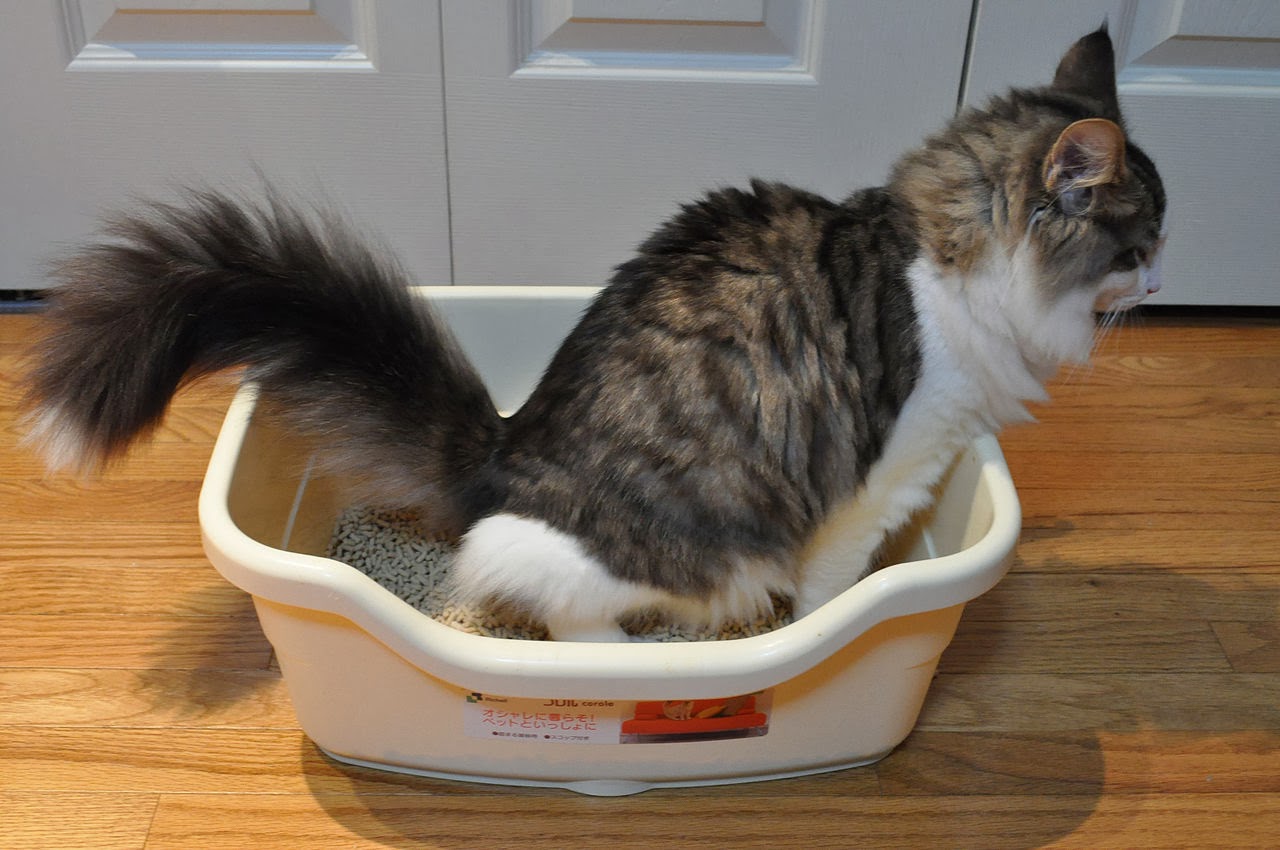 |
| Cat urinating in litter box |
1) Medical related issues such as:
a. Urinary Tract Infection: Sometimes presents blood in the urine. If possible, clean the litter box out (dump all litter & rinse) and replace litter with non- buttered popcorn kernels, or you can ask the veterinarians office for “Nosorb” litter. Either one will work. The reason for this is that you do not want the litter to absorb the urine, but cats like to have something to cover their urine up with. This enables you to take a syringe (no needle attached) and suck up the urine to bring into the veterinarian’s for analysis. If you are unable to bring the urine right into the veterinarian’s office, put the urine in the refrigerator. Make sure you write right down the time you collected it and inform the veterinarian’s office that the urine was refrigerator. If you are unable to collect your cats urine the veterinarian can perform a cystocentesis (Needle into the bladder) or express their bladder manually.
b. Blocked male cat: (this is very serious!) If you notice your male cat going into the litter box, but not producing any urine or very small amounts, take them to the veterinarians immediately. These symptoms are usually accompanied with painful meowing and sand looking material around their penis.
c. Diabetes: ( High sugar, urine can present stickiness)
d. Thyroid issues: (Usually defecating outside the litter box, but sometimes urine too.)
e. Arthritis: (Painful to get into the litter box.)
2) Behavior issues such as:
a. Anxiety
b. Territorial
3) Household issues such as:
a. Dirty litter box
b. Not enough litter boxes. Golden rule is one litter box per cat plus one. (If you have 3 cats, you should have 4 litter boxes and clean at the litter boxes at least once daily).
| Three Litter Boxes |
c. Cat does not like location. (Always place litter boxes in a quiet area and have a night light in the room, so the cat feels safe at night).
d. Cat does not like litter. (Try using two different types of litter and see if your cat uses one litter box over the other).
e. Cat does not like litter box. (Some cats do not like “hoods.” Try taking the hood off the litter box.)
f. Litter box is too small. (If your cat is larger, they might need a bigger litter box or you can try a “tote.”)
| Tote (take lid off) |
g. Cat is having an issue with another cat in the household, and is afraid to use the litter box. (Have at least one litter box located in a separate location than the other litter boxes.)
h. Some cats will urinate outside the litter box just because. (Do not leave any dirty clothes on the ground, or shoes, towels, etc.)
Please return in two weeks to learn detailed solutions for cats urinating outside the litter box. Let’s keep learning about keeping our pet(s) happy and healthy.
Sunday, February 23, 2014
My pet advice on vaccinations
Say you've just adopted your first puppy or kitten, and the shelter informs you that they have been vaccinated with their first round of shots. You think, okay that's great; I don’t have to worry about that for another year. WRONG! You must complete the full series of vaccinations, usually 3 separate rounds, before your puppy or kitten is fully protected for the year. It is important to get your pet vaccinated each year, until in my opinion your pet(s) reaches 7 years old (mature adult).
Once your pet has reached 7 years old, I recommend doing no more vaccines, and instead perform blood work. My reasoning behind this is, if your pet has been vaccinated for 7 years straight, they usually have built up enough antibodies for their whole life, so vaccines are no longer needed. In fact, vaccines for sick and/or elderly animals can actually be harmful. This is due to older animals not being able to process the vaccine properly. It’s simply just too much stress for their bodies to process.
So if your pet is 7 years or older, my pet advice would be to have a Profile (Checks for organs function), CBC (Complete blood count), and T4 (Checks thyroid) blood panel performed. These blood tests usually enable you to catch potential issues before they are a big problem. Just like vaccines were preventive care, now blood work is preventive care.
Some Veterinarians may require you to get a Rabies shot because it is required by law, but there is a way around this. If you encounter a Vet that tells you that your pet must have a Rabies shot, tell them to do a rabies titer. They will probably be shocked that you know about this, but should be willing to perform the blood test instead of the vaccine. The rabies titer is a blood test that is sent out to a lab where they check the cells to see how many antibodies for rabies your pet currently has. If they have high enough antibodies, they do not need another vaccine for a whole year.
Blood test titers can be performed for most vaccines your pet(s) receive yearly, so if you are a person who does not like a lot of vaccines, you can go this route for your pet(s).
Please return next week to learn more about keeping your pet(s) happy and healthy.
Subscribe to:
Posts (Atom)





